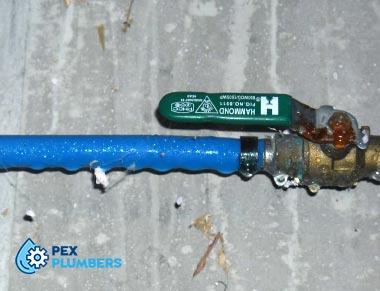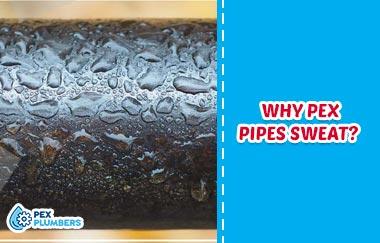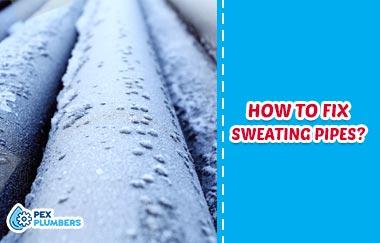The PEX pipe is one that is commonly replacing old copper pipes everywhere, for the plethora of advantages they bring. They are efficient, durable, easy to work with, etc. But, one thing we cannot escape unfortunately is sweating.

PEX pipes sweat, and it is unfortunate. But the good news is that you can prevent this from happening!
One of the biggest reasons why this happens is because of the weather, so we really cannot blame this phenomenon on anything specifically.
But we can find out more about all the causes, their possible solutions, and how we can prevent this from happening.
If you use PEX tube, and you wish to know more, then check out the entire detailed piece answering- does PEX pipe sweat: cause, solution, prevention, and hopefully, you won’t have to face the problem anymore!
Why PEX Pipes Sweat? Some of The Main Reasons

Changing Temperatures
Whether it is the peak of summer or the peak of winter, PEX pipes can sweat due to such temperatures.
1. Summer
In the hotter months, this happens more. This is because even though you have a PEX pipe, the main pipe where the water is supplied is made from copper. In copper pipes, the water is usually cooler, and then this cool water is transferred into the PEX pipe.
The PEX pipe has warmer air inside it during the summer and then is suddenly met with the colder water from the copper pipes. When this extra humidity inside the PEX pipes comes into contact with cold water, the walls of the pipe start to sweat.
This meeting of the two opposite temperatures causes a convection process, and eventually condensation. And this is how you get sweat-covered pipes, which, in some cases, can create puddles even.
2. Winter
The same can happen in the colder months too, except this time the temperatures are typically opposite. If you notice this happening in the wintertime as well, then it also means that your home is poorly insulated.
In colder months, the sweating occurs mostly in pipes that are closer to the building, or in the basement, where spaces are not well insulated.
Also Read: Is Copper Better Than PEX? (COMPLETE GUIDE)
How to Fix Sweating Pipes?

Now that you know what causes the sweating, fixing it will not be a big problem anymore. All you have to do is ensure that the condensation does not occur. And for this you need insulation.
Let us see how we can do that, shall we?
1. Fiberglass
Fiberglass is very well known for its insulating properties, and fiberglass pipe wrap is one that has been made specially to insulate pipes. This is basically spun fiberglass wool that comes with a polyethylene vapor barrier on the back.
You take this wrap and wrap it around the pipes you wish to insulate, and tape it nice and tight.
These wraps can help to cover the entire pipes, and you can use plastic elbows when working with curved pipes or corners.
You may also use fiberglass encapsulation, which works similar to this, but provides cleaner joints and is more rigid and firmer. These have an R-value of 4, up to 12.
Relevant post >> How Long Does Pex Piping Last
2. Polyurethane Foam Pipe
This is your basic foam pipe that has a slit on one side and can be easily placed on the PEX pipe. These usually come in sizes of 4 to 6 feet in length. You can cut them up according to your needs, or add on more if you have to insulate longer lines of pipes.
These have an R-value of 4, which is not a lot, but just enough to prevent sweating. This would work well for the wintertime, or if you have an adequately insulated home.
3. Polyurethane Spray Foam Pipe
A Polyurethane Spray Foam Pipe is most commonly used in commercial buildings where you require a high level of insulation.
Here, a clear plastic shell is placed over the pipe, and then polyurethane foam is sprayed on top of it or poured onto it. It creates a complete encapsulation leaving no gaps, and this is what makes this process so effective.
It has an R-value of 7 up to 14, which is very good. But because of this, it is also very expensive, which is why it is mostly left to commercial usage.
4. Prevention For PEX Pipe Sweating
Prevention is better than cure. Leaving sweating pipes can result in molds growing all over, and that is one of the unhealthiest things that can happen to a home.
For this reason, the best thing to do right now is to ensure that your pipes don’t catch moisture. And for this, you should look into insulation as soon as possible!
A few ways have been mentioned above, and you can pick one that suits your needs the best. That way, you don’t have to constantly worry about the sweating, and don’t have to clean up after either!
Conclusion
We hope this clears all your troubles with PEX pipes sweating. Some people might be new to this, while others can know a ton.
But there is no harm in taking in useful information, especially when it can save you so much trouble down the line if you know what to do now!
So, if someone asks you does PEX pipe sweat? then i think you can clearly describe that. Because in this article i try to give you a complete guideline of PEX pipe sweating.
Relevant Article:
- Where is PEX Not Allowed or Banned? Why Is That?
- Stop Brass Fittings From Leaking: Easy Way
- Easy guide for Use Flex Tape
- Types of Flux for Copper Pipe
- A list of Good Quality Water Hammer Arrestor

Hey! I’m Leanda Bailey. I’m here to explain every plumbing installation and repair you may have in your kitchen or bathroom. Also, I’ll try to find you the best products on the market for your plumbing work.
